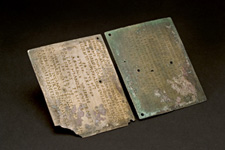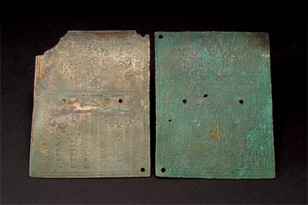These two plates were issued by imperial decree on October 14, AD 109, during the rule of emperor Trajan in Rome. [Figure 1] The text on the plates announces the grant of military honors and citizenship rights to retiring soldiers who served in nineteen units of the Roman army. The text then specifically grants those honors and rights to the soldier Marcus Herennius Polymita and his family. Each qualifying, retiring soldier included in the cohorts listed would have been given his own personalized set of plates. In the first century, no civic status was more powerful than that of Roman citizenship, a privilege enjoyed by a small percent of the empire’s population at the time of Trajan.
Download a High Definition version of this video
(To view videos you must have Quicktime 7 installed)

Figure 1
These two plates were designed to be bound together. They are the same size, and after almost two thousand years of contact, they conform to each other in shape and surface features. The full text of the imperial decree is cast in portrait format on the front of plate 1 (side A). The very same text is inscribed in landscape format on the back of plate 1 (side B) and over onto the front of plate 2 (side C). On the back of plate 2 (side D) are cast the names of the seven witnesses or officials under whose authority these plates were issued. When the two plates are stacked and bound together, sides A and D become the two exterior faces of the sealed pair, and sides B and C become the protected interior faces.
The text on the outside face of plate 1 (side A) was an imperial decree or grant. This particular diploma granted citizenship to soldiers from all over the empire retiring after the conquest of Dacia. Another plate with the same text was publicly posted on a temple wall in Rome, represented by the marble slab on the exhibition wall. Because so many soldiers were given citizenship under one decree, the plate posted in Rome was likely accompanied by a single list of names of the retiring individual soldiers.
Download a High Definition version of this video
(To view videos you must have Quicktime 7 installed)






